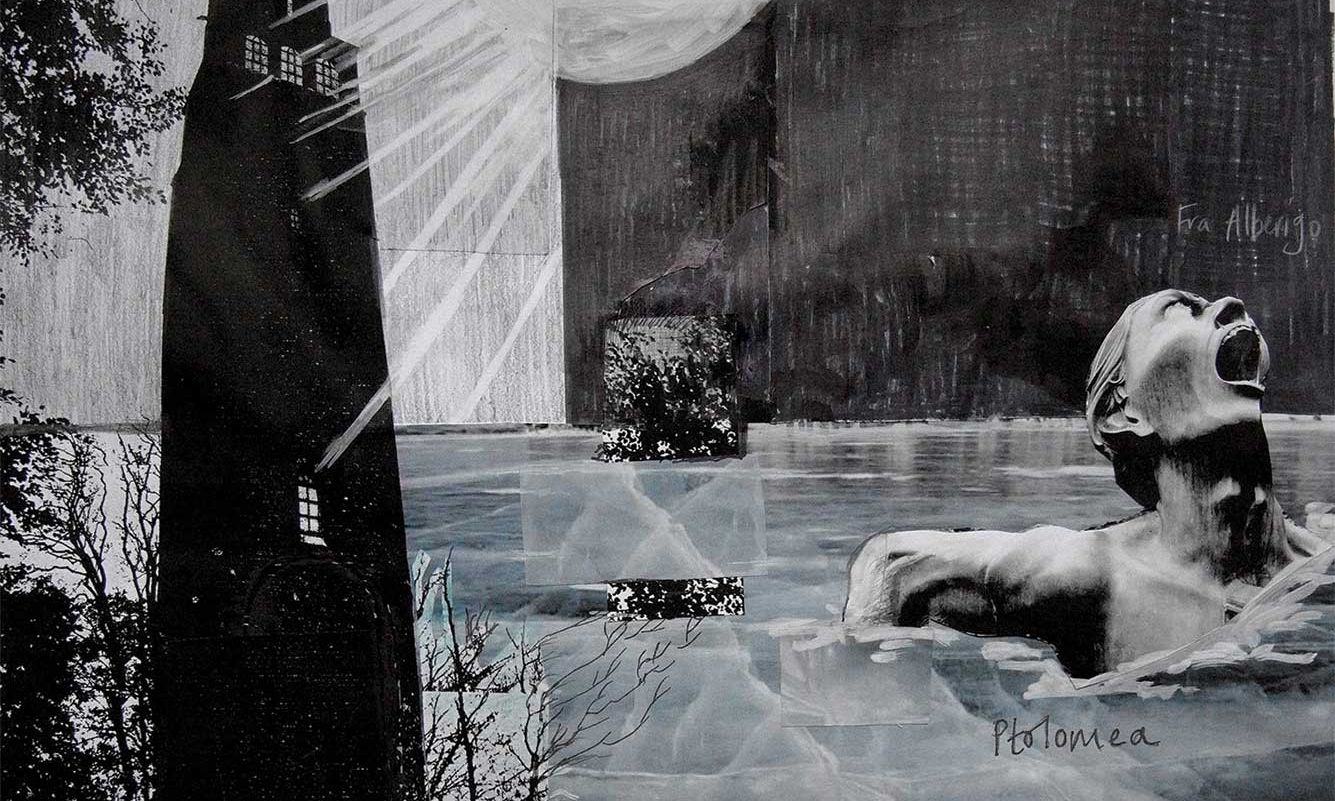Rachel Owen, Canto XXXIII: The Traitors Frozen in Cocytus (Antenora and Ptolomea). Ugolino tells his tale of betrayal and death in “the tower now called Hunger”, while Fra Alberigo begs Dante to remove the ice freezing his face so he can let vent to his agony. From Illustrations for Dante’s Inferno (2016) © The estate of Rachel Owen
In a timely reminder, given the mess mankind is in, the Bodleian Library has produced two striking books that address what it is to be human—life and afterlife. Sociopaths past and present probably won’t care that “The paths of Glory lead but to the Grave”, as stated in Thomas Gray’s Elegy Written in a Country Churchyard. While—offering some hope to the rest of us—Dante’s Inferno describes a multitude of excruciating, interminable reckonings for the self-serving charlatans and downright villains from every period of history. Amen to that.
Gray’s celebrated poem, first published in 1751, with many familiar lines—“Far from the madding crowd’s ignoble strife”—is a meditation on death and remembrance as the narrator-poet surveys the modest graves of everyday rural souls. It has inspired some of the greatest British artists, notably William Blake and John Constable, as poet Carol Rumens outlines in her elegant introduction to this bijou collector’s edition. And judging from the bold monochrome and profoundly soulful images by Agnes Miller Parker (1895-1980) here accompanying each stanza—created on the cusp of the Second World War—Parker rightly sits among them.
Born in Ayrshire, Parker trained at the Glasgow School of Art, later teaching there, and after moving to London in 1920 was influenced by Cubism and Vorticism, particularly the work of William Roberts. Relocating to Wales ten years later, Parker became known for her wood engravings produced for the Gregynog Press, Powys, including The Fables of Esope (1932), Welsh Gyspy Folk-Tales (1933) and later Gray’s Elegy (1938).
For the Elegy, her designs acknowledge Richard Bentley’s (1753) earliest and emphatically pastoral illustrations, while combining Blake’s twisting sinews with a Vorticist’s sculptural figuration. Initially self-taught in the wood-engraving medium, Parker quickly achieved technical virtuosity, as is evident in the wonderful chiaroscuro touched with silvery brilliance. The effect, even in miniature, has a quiet yet powerful energy.
Agnes Miller Parker, “The bosom of his Father and his God” from Elegy Written in a Country Churchyard (1938) © The Estate of Agnes Miller Parker, 2021
Far less comforting are Rachel Owen’s eerily beautiful scenes from Dante’s Inferno, which combine her skill as a photographer/printmaker with deep art-historical and literary scholarship. Owen was born in 1968 in Cardiff, and the subject of her doctorate and subsequent teaching at Oxford University—representations of the Florentine poet and his most celebrated work—was an obsession until her tragically early death in 2016.
Like Gray’s Elegy, Dante’s journey through the Circles of Hell (written between around 1308 and 1320), witnessing the plight of various sinners, has lent itself to pictorial representation since inception: whether covering the entirety, most famously Sandro Botticelli, William Blake and Gustave Doré, or via individual scenes, such as the murdered adulterer Francesca and her lover, or Count Ugolino, condemned by his enemy, along with his children, to a death sentence by starvation.
In Owen’s suitably uncanny visions, the poet is not represented; rather the viewer sees all through Dante’s eyes. Furthermore, Owen foregrounds women (she herself appears as Dante’s guardian angel Beatrice) in a work dominated by male characters. Her process—preparatory mixed-media collages (photocopies of photographs, acrylic paint, biro inscriptions) which are then reduced and replicated via photographic print—serves to intensify these part-figurative, part-fragmented scenes. Hell’s chilling environment is rendered in oppressive black and white, with the occasional touch of colour, such as the cool blue suggesting ice in the image for Canto XXXIII.
In the anniversary year of Dante’s death, this publication, which brings Owen’s art to a broader audience, is a double act of celebration and remembrance.
• Thomas Gray, with wood engravings by Agnes Miller Parker, Elegy Written in a Country Churchyard (Collector’s Edition), Bodleian Library Publishing, 88pp, 33 b/w illus., £16.99 (hb), publication October 2021
• David Bowe, ed., Rachel Owen: Illustrations for Dante’s Inferno, Bodleian Library Publishing, 128pp, 52 colour illus., £25 (hb), publication September 2021
• Jacqueline Riding is contributing editor, books for The Art Newspaper and author of Hogarth: Life in Progress (Profile, 2021)
We use cookies to personalise content and ads, to provide social media features and to analyse our traffic. We also share information about your use of our site with our social media, advertising and analytics partners who may combine it with other information that you’ve provided to them or that they’ve collected from your use of their services. Read our Cookie Policy for more information.

